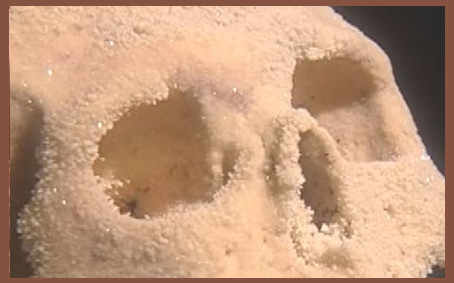The Cave of the Talgua River (La Cueva del Rio Talgua) is exactly what many people picture when they hear the word "cave." Located near the town of Catacamas, Honduras, its chambers are filled with formations shaped like stone waterfalls as well as a rushing stream that twists and turns through the entire two-mile cave.
No one knew,  though, that the Cave of the Talgua River held a very special treasure until a day in April 1994 when Jorge Yanez and three friends waded through the stream to a spot halfway into the cave.
though, that the Cave of the Talgua River held a very special treasure until a day in April 1994 when Jorge Yanez and three friends waded through the stream to a spot halfway into the cave.
There, they happened to look up and see a small opening in the ceiling, well above their heads. Curious about this possible passageway, Jorge hurried back to Catacamas and returned with a ladder. Then he and his friends climbed into the opening and discovered a chamber that had remained hidden for 3,000 years.
Their helmet lights illuminated beautiful stone curtain formations that hung from the ceiling to the floor. At first, the shadows cast by the stone curtains blocked the men's vision. As their eyes adjusted to the light, they saw something more than a spectacular geological formation--for, tucked between the curtains, in crevices and on ledges, were ceramic bowls and piles of human skulls and bones. Over the years, they had become covered with sparkling calcite crystals. Now they seemed to glow in the bright lights.
The young men had discovered a place that archaeologists call an ossuary, a place where bones of the dead are kept. They took some pictures but left the chamber undisturbed. Then they reported their discovery to an archaeologist at the Institute of Anthropology and History in Tegucigalpa, the capital of Honduras. Within a month, an expedition was organized and a group of archaeologists were able to see the cave with its upper chamber. News of the discovery had spread and the cave was given a new name: The Cave of the Glowing Skulls.
The archaeologists uncovered some interesting details. First, the bones were placed in stacks, not laid out as normal skeletons. They took this to mean that the bodies had first been buried somewhere else. When the flesh had decayed, the bones were carried to the cave and placed in stacks for final burial. Second, under the calcite crystals, the scientists found evidence that the bones had been painted red, which may have been part of a burial ceremony. Third, some of the skulls were deformed, because as infants the heads had been bound or wrapped tightly in cloth. Archaeologists know that important members of some societies often had their heads bound when they were infants as a special status symbol.
Finally, radiocarbon tests conducted on bone and pottery samples from the cave indicated that the burials took place approximately 900 B.C. This was the most important finding of all, for the people who buried their relatives in the Cave of the Rio Talgua were members of one of the oldest civilizations ever discovered in Central America, even older than the Maya Civilization which flourished between A.D. 250 and 1000.
But what happened to them? Why did they stop using the cave? Did they move to a new area? Were they defeated in combat? No one knows, but 3,000 years after they vanished, they suddenly reappeared when Jorge Yanez and his friends decided to explore a cave.

Copyright © James M. Deem. Taken from an unpublished manuscript by James M Deem. All rights reserved.

Other Cave Stories by James M Deem
Floyd Collins: Trapped in Sand Cave! The Cave of Glowing Skulls
The Cave of Glowing Skulls
The Hidden Treasure of Lascaux Six Months Alone in Midnight Cave
Six Months Alone in Midnight Cave